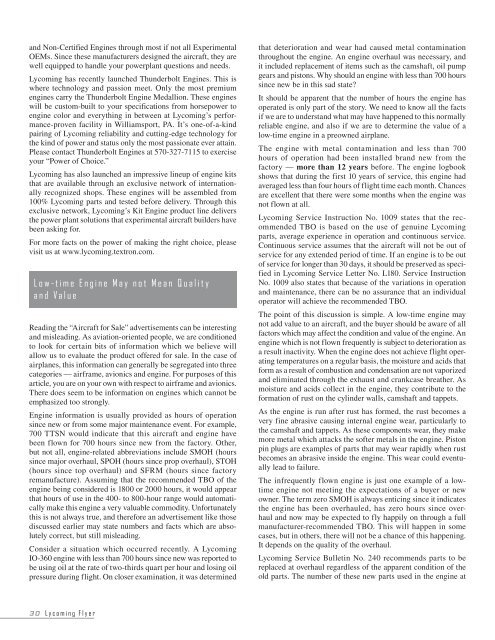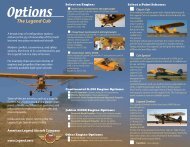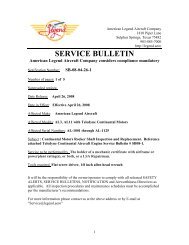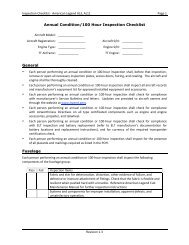Lycoming Flyer - Aircrafts sales, engines repair, spare parts
Lycoming Flyer - Aircrafts sales, engines repair, spare parts
Lycoming Flyer - Aircrafts sales, engines repair, spare parts
- No tags were found...
Create successful ePaper yourself
Turn your PDF publications into a flip-book with our unique Google optimized e-Paper software.
and Non-Certified Engines through most if not all ExperimentalOEMs. Since these manufacturers designed the aircraft, they arewell equipped to handle your powerplant questions and needs.<strong>Lycoming</strong> has recently launched Thunderbolt Engines. This iswhere technology and passion meet. Only the most premium<strong>engines</strong> carry the Thunderbolt Engine Medallion. These <strong>engines</strong>will be custom-built to your specifications from horsepower toengine color and everything in between at <strong>Lycoming</strong>’s performance-provenfacility in Williamsport, PA. It’s one-of-a-kindpairing of <strong>Lycoming</strong> reliability and cutting-edge technology forthe kind of power and status only the most passionate ever attain.Please contact Thunderbolt Engines at 570-327-7115 to exerciseyour “Power of Choice.”<strong>Lycoming</strong> has also launched an impressive lineup of engine kitsthat are available through an exclusive network of internationallyrecognized shops. These <strong>engines</strong> will be assembled from100% <strong>Lycoming</strong> <strong>parts</strong> and tested before delivery. Through thisexclusive network, <strong>Lycoming</strong>’s Kit Engine product line deliversthe power plant solutions that experimental aircraft builders havebeen asking for.For more facts on the power of making the right choice, pleasevisit us at www.lycoming.textron.com.Reading the “Aircraft for Sale” advertisements can be interestingand misleading. As aviation-oriented people, we are conditionedto look for certain bits of information which we believe willallow us to evaluate the product offered for sale. In the case ofairplanes, this information can generally be segregated into threecategories — airframe, avionics and engine. For purposes of thisarticle, you are on your own with respect to airframe and avionics.There does seem to be information on <strong>engines</strong> which cannot beemphasized too strongly.Engine information is usually provided as hours of operationsince new or from some major maintenance event. For example,700 TTSN would indicate that this aircraft and engine havebeen flown for 700 hours since new from the factory. Other,but not all, engine-related abbreviations include SMOH (hourssince major overhaul, SPOH (hours since prop overhaul), STOH(hours since top overhaul) and SFRM (hours since factoryremanufacture). Assuming that the recommended TBO of theengine being considered is 1800 or 2000 hours, it would appearthat hours of use in the 400- to 800-hour range would automaticallymake this engine a very valuable commodity. Unfortunatelythis is not always true, and therefore an advertisement like thosediscussed earlier may state numbers and facts which are absolutelycorrect, but still misleading.Consider a situation which occurred recently. A <strong>Lycoming</strong>IO-360 engine with less than 700 hours since new was reported tobe using oil at the rate of two-thirds quart per hour and losing oilpressure during flight. On closer examination, it was determinedthat deterioration and wear had caused metal contaminationthroughout the engine. An engine overhaul was necessary, andit included replacement of items such as the camshaft, oil pumpgears and pistons. Why should an engine with less than 700 hourssince new be in this sad state?It should be apparent that the number of hours the engine hasoperated is only part of the story. We need to know all the factsif we are to understand what may have happened to this normallyreliable engine, and also if we are to determine the value of alow-time engine in a preowned airplane.The engine with metal contamination and less than 700hours of operation had been installed brand new from thefactory — more than 12 years before. The engine logbookshows that during the first 10 years of service, this engine hadaveraged less than four hours of flight time each month. Chancesare excellent that there were some months when the engine wasnot flown at all.<strong>Lycoming</strong> Service Instruction No. 1009 states that the recommendedTBO is based on the use of genuine <strong>Lycoming</strong><strong>parts</strong>, average experience in operation and continuous service.Continuous service assumes that the aircraft will not be out ofservice for any extended period of time. If an engine is to be outof service for longer than 30 days, it should be preserved as specifiedin <strong>Lycoming</strong> Service Letter No. L180. Service InstructionNo. 1009 also states that because of the variations in operationand maintenance, there can be no assurance that an individualoperator will achieve the recommended TBO.The point of this discussion is simple. A low-time engine maynot add value to an aircraft, and the buyer should be aware of allfactors which may affect the condition and value of the engine. Anengine which is not flown frequently is subject to deterioration asa result inactivity. When the engine does not achieve flight operatingtemperatures on a regular basis, the moisture and acids thatform as a result of combustion and condensation are not vaporizedand eliminated through the exhaust and crankcase breather. Asmoisture and acids collect in the engine, they contribute to theformation of rust on the cylinder walls, camshaft and tappets.As the engine is run after rust has formed, the rust becomes avery fine abrasive causing internal engine wear, particularly tothe camshaft and tappets. As these components wear, they makemore metal which attacks the softer metals in the engine. Pistonpin plugs are examples of <strong>parts</strong> that may wear rapidly when rustbecomes an abrasive inside the engine. This wear could eventuallylead to failure.The infrequently flown engine is just one example of a lowtimeengine not meeting the expectations of a buyer or newowner. The term zero SMOH is always enticing since it indicatesthe engine has been overhauled, has zero hours since overhauland now may be expected to fly happily on through a fullmanufacturer-recommended TBO. This will happen in somecases, but in others, there will not be a chance of this happening.It depends on the quality of the overhaul.<strong>Lycoming</strong> Service Bulletin No. 240 recommends <strong>parts</strong> to bereplaced at overhaul regardless of the apparent condition of theold <strong>parts</strong>. The number of these new <strong>parts</strong> used in the engine at3 0 L y c o m i n g F l y e r









